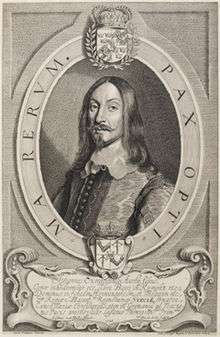Johan Oxenstierna
| The High Well Born Count Johan Oxenstierna | |
|---|---|
 | |
| Marshal of the Realm | |
|
In office 1654–1657 | |
| President of the Wismar Tribunal | |
|
In office 1655–1657 | |
| Personal details | |
| Born |
24 June 1611 Stockholm |
| Died | 5 December 1657 (aged 46) |
| Nationality | Swedish |
| Spouse(s) | Margareta Brahe |
| Relations |
Axel Oxenstierna (father) Anna Bååt (mother) Kristina Oxenstierna (sister) Erik Oxenstierna (brother) |
| Occupation | Statesman |
| Religion | Evangelical Lutheran |
Johan Axelsson Oxenstierna af Södermöre (24 June 1611 – 5 December 1657) was a Count and a Swedish statesman.
Biography
The son of Axel Oxenstierna, he was born in Stockholm. He completed his studies at Uppsala in 1631, and was sent by his father on a grand tour through France, the Netherlands and Great Britain. He served under his brother-in-law Count Gustav Horn af Björneborg in the Thirty Years' War from 1632, and was subsequently employed by his father in various diplomatic missions, though his instructions were always so precise and minute that he was little more than the executor of the Chancellor's wishes. He was one of the commissioners who signed the truce of 1635 with Poland (Armistice of Stuhmsdorf or Treaty of Sztumska Wieś), and in 1639, much against his father's will, was made a Privy Councillor.
Along with Salvius he represented Sweden at the great peace congress of Osnabrück, but as he received his instructions direct from his father, whereas Salvius was in the queen's confidence, the two "legates" were constantly at variance. From 1650 to 1652 he was Governor General of Swedish Pomerania. King Charles X Gustav made him Marshal of the Realm.
See also
Notes
References
-
 This article incorporates text from a publication now in the public domain: Robert Nisbet Bain (1911). "Oxenstjerna". In Chisholm, Hugh. Encyclopædia Britannica (11th ed.). Cambridge University Press.
This article incorporates text from a publication now in the public domain: Robert Nisbet Bain (1911). "Oxenstjerna". In Chisholm, Hugh. Encyclopædia Britannica (11th ed.). Cambridge University Press.
| Court offices | ||
|---|---|---|
| Preceded by Adolph John of Pfalz-Zweibrücken |
Marshal of the Realm 1654–1657 |
Succeeded by Gabriel Gabrielsson Oxenstierna |
| Legal offices | ||
| Preceded by ? |
President of the Wismar Tribunal 1655–1657 |
Succeeded by ? |
| Titles of nobility | ||
| Preceded by Axel Oxenstierna |
Count of Södermöre Baron of Kimito 1st creation 1654–1657 |
Succeeded by ? |